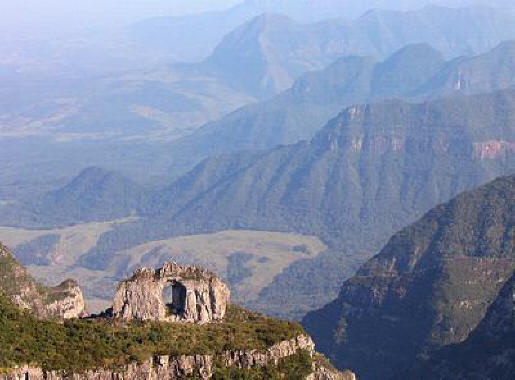
home •
about •
essential guide •
picture of the day •
thunderblogs •
news •
multimedia •
predictions •
products •
get involved •
contact
picture of the day archive subject index
Stone arch in Morro da Igreja, Brazil. Credit: pilottoregis.
Sep 22, 2008
Natural Arches
Most geographical features on this planet are theorized to be the ancient remnants of wind and rain acting over thousands of centuries. Could they actually be young and created by electricity?Previous Picture of the Day articles have dealt with unusual structures on this planet: stone monoliths, craters, canyons, and many other formations that are not easy to explain from a conventional perspective. Some appear to have been cut into the rock by a hot knife, and some to have been pulled up and out of the ground as if a tremendous force gripped the stone and yanked it skyward, leaving mounds and needle shapes behind.
Another item in the long list of topographical anomalies from around the world is the arches carved into cliffs and mountaintops on every continent. They are located in dense jungles, deserts, and seaside locales, so they must be formed through some process that can act in a similar fashion irrespective of the environment or the altitude at which they are found. The arches pierce through any type of mineral one cares to imagine: limestone, sandstone, or dolerite. An examination of sites with the hardest igneous slabs like Okno Ohniste in Slovakia to those with the softest sediments like Sugarloaf Arch in the Gilf Kebir wasteland of Egypt demonstrates their striking similarity.
Many arches share several other unique aspects: for example, there is no large stone debris from the aeolian processes that are said to have eroded them in arid regions. Although the wind is supposed to blow the fine particles away, large blocks should also have broken free but they are absent in practically every case. In other areas where there is a substantial amount of rainfall, the arches are selectively bored through the cliffs. The question that naturally comes to mind is why neighboring cliffs, identical in composition, oriented in the same direction, and with matching exposure to the rain, do not also have arches?
There are other atypical arches that stand in solitude with square-shaped openings and no large boulders littering the landscape around their openings. One such is the unnamed arch in the Morro da Igreja mountains of Brazil, alone on top of a solid limestone peak with no remnant rocks, large or small, around its base. Another much monumental solitary arch with a square hole is Torghatten in Norway.
Torghatten is itself a monolithic stone tor drilled through-and-through by a tunnel 160 meters long, 35 meters high, and 20 meters wide. According to legend, it was created by Hestmannen's arrow when the king of Sømna blocked its path with his hat. The hat fell to the ground and at the moment the sun rose, everything turned to stone.
Cerro Autana in Venezuela is another stone monolith with a tunnel hewn clean through its structure. The 1400 meter tower is composed of solid quartzite, exhibiting a distinct twist all the way up from its base to its table-top summit. The cavern within the silicon dioxide matrix is an enormous geode, 430 meters long and 43 meters high that cannot be explained by simple erosion or chemical disintegration.
Since the Electric Universe hypothesis identifies electricity as the formative agent for these geological configurations, they might be found elsewhere in the solar system. Mars might have them, but because the images available to us are taken from spacecraft in orbit, only the top portions of what could be arches are visible. So far, no roving vehicles have landed near the crevasses or the kilometers-high mountains on Mars, so it is possible that future missions will uncover more puzzles to unravel.
As we have postulated in past articles, electric discharges with energies equivalent to thousands of hydrogen bombs going off all at once might have created the deep chasms and vertical heights that we see—not just on Earth but on other planets as well. The same energetic events could have also electrically machined the arches, vaporizing the strata and carrying the material away in a vortex of plasma.
By Stephen Smith
___________________________________________________________________________Please visit our Forum
The Electric Sky and The Electric Universe available now!

|
|

|
EXECUTIVE EDITORS:
David Talbott, Wallace Thornhill
MANAGING EDITORS:
Steve Smith, Mel Acheson
CONTRIBUTING EDITORS: Michael Armstrong, Dwardu Cardona,
Ev Cochrane,
C.J. Ransom, Don Scott, Rens van der Sluijs, Ian Tresman
WEBMASTER: Brian Talbott
Copyright 2007: thunderbolts.info
![]()
home •
thunderblogs •
forum •
picture of the day •
resources •
team •
updates •
contact us

